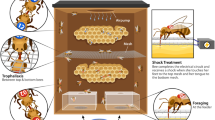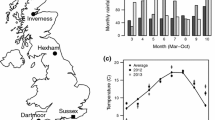Abstract.
Exchange of liquid food among adults (trophallaxis) is documented for the first time in New World sweat bees (Halictinae). Megalopta genalis and M. ecuadoria are facultatively social, and in social groups foragers regularly give food to the oldest resident female bee, which dominates social interactions. In turn, the oldest resident sometimes re-distributes this food, and shares it with younger foragers. Food is sometimes offered freely, but often the dominant bee exhibits escalating aggressive behavior until she is fed, whereupon she immediately ceases to be aggressive. The occurrence of trophallaxis in a species with mass-provisioned larvae provides an opportunity to examine the ritualization of social behavior. Trophallaxis also increases survivorship of males and females by almost 50% under experimental conditions, suggesting the behavior is also important in ecological contexts.
Similar content being viewed by others
Author information
Authors and Affiliations
Corresponding author
Additional information
Received 25 July 2005; revised 22 November 2005; accepted 23 December 2005.
Rights and permissions
About this article
Cite this article
Wcislo, W.T., Gonzalez, V.H. Social and ecological contexts of trophallaxis in facultatively social sweat bees, Megalopta genalis and M. ecuadoria (Hymenoptera, Halictidae). Insect. Soc. 53, 220–225 (2006). https://doi.org/10.1007/s00040-005-0861-6
Issue Date:
DOI: https://doi.org/10.1007/s00040-005-0861-6




